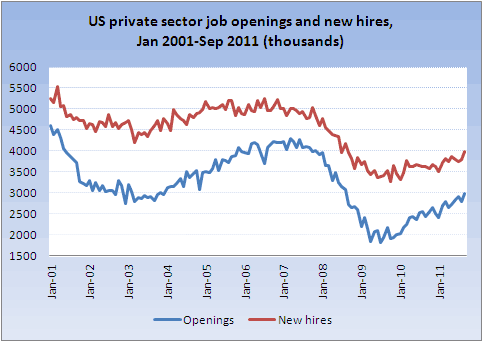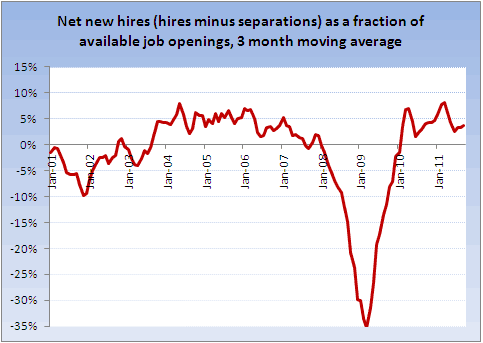Earlier this week the BLS released new data on the number of job openings, hires, and separations in the US labor market for September 2011. The headline story from that news release was that the number of job openings in the US continued what has been a pretty solid and steady rise over the past year.
Some have interpreted this news as possible evidence that the US labor market is beset with structural unemployment problems; if the number of job openings is increasing so strongly, then the relatively slow increase in the level of employment must be due to the fact that unemployed workers are mismatched to the types of jobs that are available, right? The unemployment problem in the US, the reasoning goes, must be significantly the result of this worker-job mismatch — which is a “structural” problem — rather than low demand. From the FT:
High US joblessness puzzles economists
The stubbornness of high unemployment despite a steady rise in the number of job openings in the US since the end of the recession is posing a puzzle to economists as they try to understand the troubled labour market.
New data released this week show that the number of vacant jobs in the US rose to 3.4m in September – the highest in more than two years – even as the unemployment rate remains mired at 9 per cent.
The question is whether the rising rate of job openings, derived from the Job Openings and Labour Turnover Survey, is the better indicator of a steady recovery in the labour market or whether the fact that vacancies are being advertised but not filled points to an underlying malaise…
But I don’t actually think that this data actually provides any support for the structural explanation of the US’s stubbornly high unemployment rate. While the number of job openings has indeed risen substantially over the past year or two, that was from an abysmally low level in 2009. Even now, the total number of private sector job openings is just barely back to the level of jobs available at the worst of the 2001-03 employment recession in the US, as shown below.

The fact is that there are still terribly few jobs available relative to what is normal for the US economy. Meanwhile, the number of net new hires (i.e. total new hires minus the number of worker separations due to both voluntary quitting and involuntary layoffs) has been averaging about 100 thousand people per month recently, which is disappointingly small. But compared to the relatively small number of job openings, this is actually fairly decent performance. Dividing the number of net new hires by the number of available job openings we find that jobs are actually being filled at a decent rate — more or less at the same rate as during the relatively good labor market years of 2004-07.

This suggests that it is not any more difficult to match people with positions today than usual. The dominant feature of today’s job market is simply that there are still very few job openings; companies in the US remain reluctant to hire more people. That is not the result of any structural, skills-mismatch sort of problem. That is simply the result of firms feeling that they do not yet need to hire more workers. It’s yet more evidence (see here for another type of evidence) that the US’s unemployment problem is the result of plain old insufficient demand.
- Bulenox: Get 45% to 91% OFF ... Use Discount Code: UNO
- Risk Our Money Not Yours | Get 50% to 90% OFF ... Use Discount Code: MMBVBKSM
Disclaimer: This page contains affiliate links. If you choose to make a purchase after clicking a link, we may receive a commission at no additional cost to you. Thank you for your support!



Leave a Reply